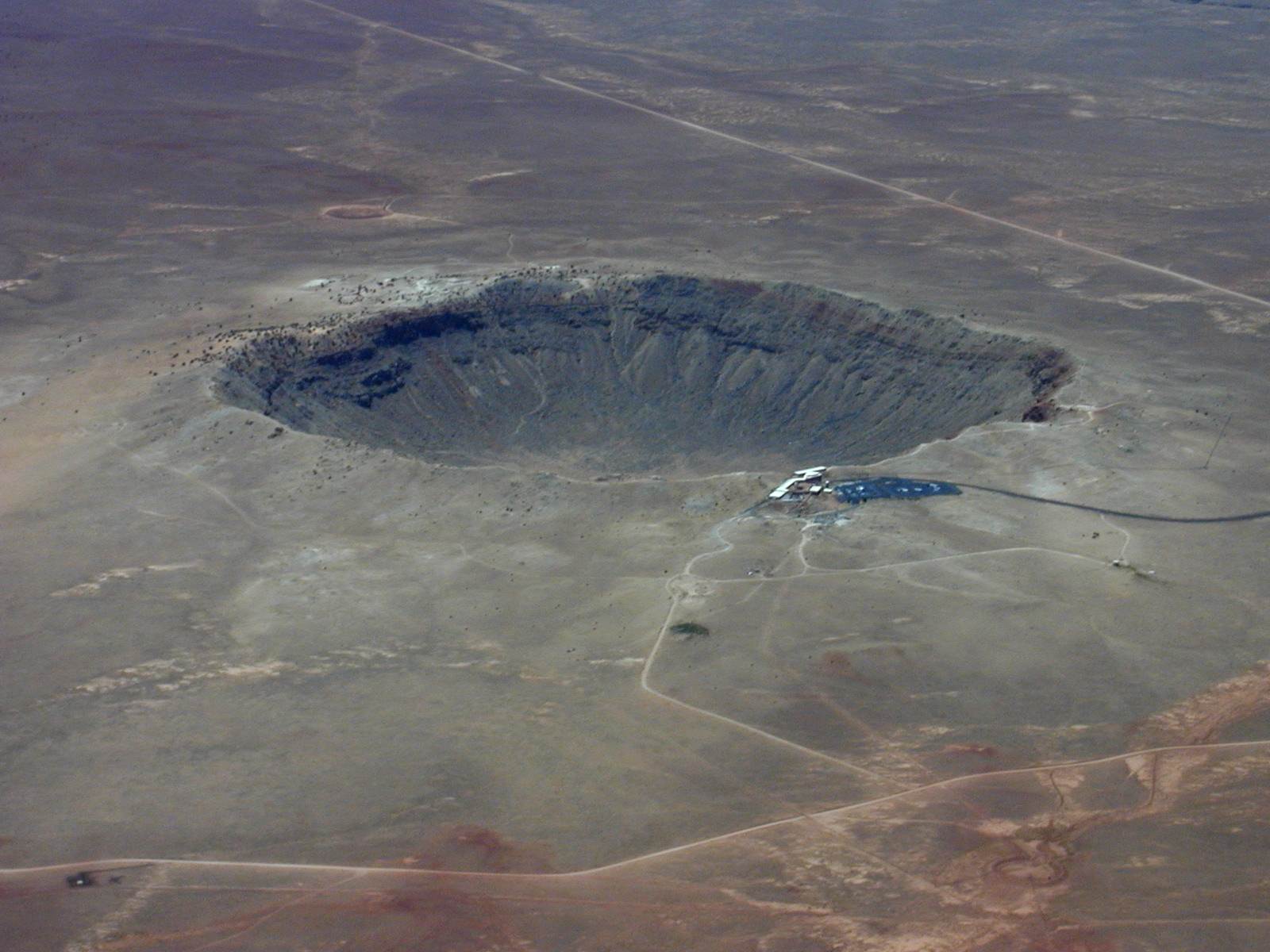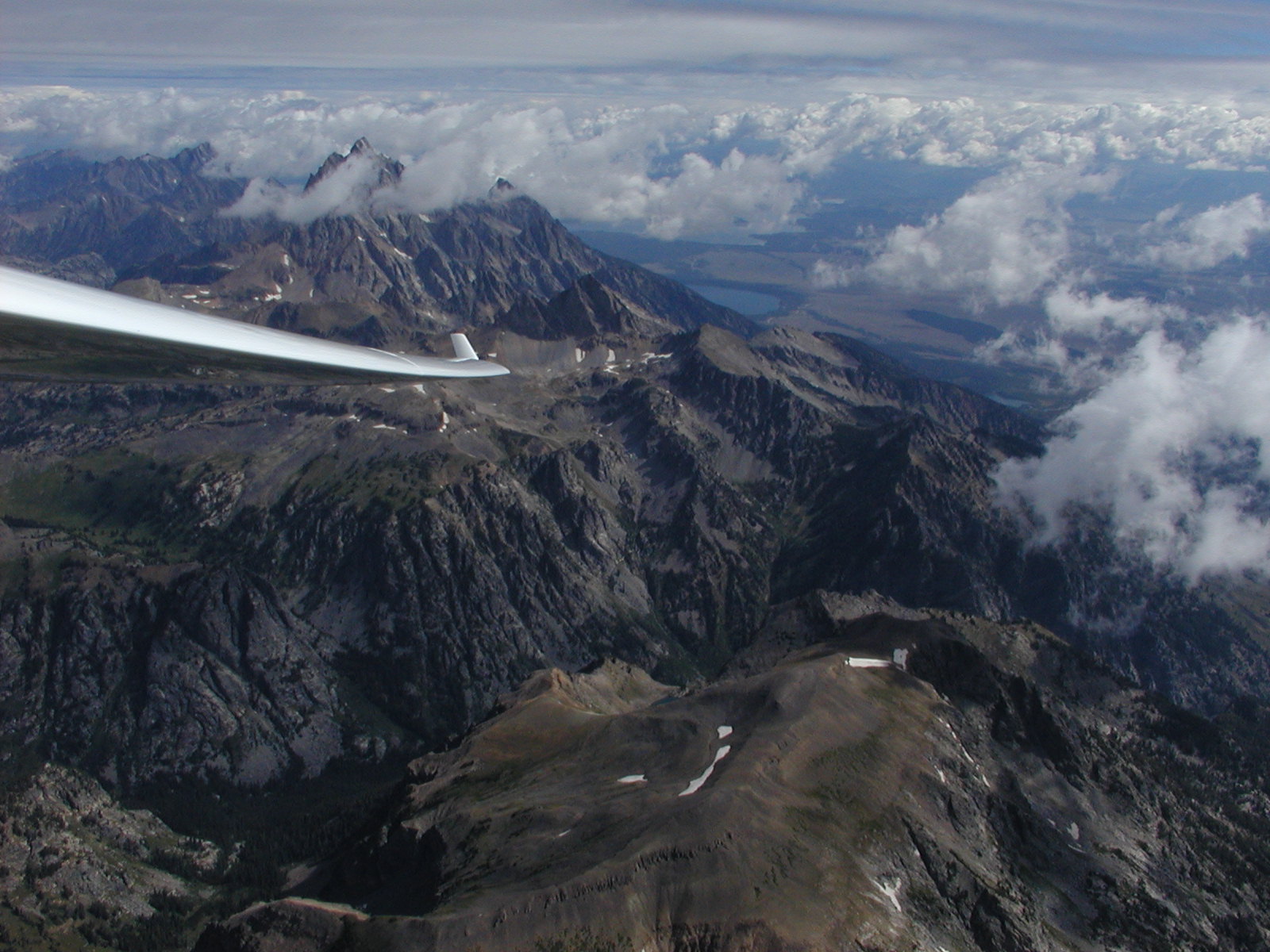
Note: All photos can be seen at higher resolution by downloading. In most browsers this is accomplished by right-clicking on the photo and then selecting an option such as "Save Picture As" (Windows) or "Save Image to" (Mac OS X). With a single button mouse, control-clicking (holding the CTRL key while clicking) usually is equivalent.
These two photos were taken two years and 600 miles apart. They are grouped here only for convenience.

Meteor Crater: This photo was taken on the same June 2004 soaring safari that included Telluride, Colorado. The safari started from Hayward with stops at Tonopah NV, Flagstaff AZ, Santa Fe NM, Telluride CO, Ely NV and then back to Hayward. As I planned the third leg, from Flagstaff to Santa Fe, I realized that it would take me very close to Meteor Crater, so I deviated slightly to take in this impressive sight.
Meteor Crater was formed 50,000 years ago when a meteorite weighing several hundred thousand tons struck the earth with the force of a 20 megaton bomb. The resulting crater was about 700 feet deep, but erosion has reduced that to 550 feet today. The crater is over 4000 feet in diameter.
I was able to soar almost all the way from Flagstaff to Santa Fe, including the part of the flight when this picture was taken. I used only 18 minutes of engine time in three short runs during the 4.9 hour flight. But there is a price to pay for having so much fun. Since stopping to circle in a thermal temporarily reduces my average speed to zero, my average speed for the flight was only 65 mph. A typical small power plane flies two to three times as fast. But speed was not my goal and 65 mph is respectable if compared to automobile travel instead of air. Plus I achieved 400 mpg, which compares very favorably to 10-20 mpg for a typical small power plane and 15-40 mpg for most cars.

The Grand Tetons National Park: I have been fascinated with the Grand Tetons ever since I was a small child and saw my parents' Kodachrome slides from their 1940 cross-country automobile trip (NY to San Francisco and back). I first saw the Tetons in 1967 when my new wife and I were returning to California from a wedding reception my parents had given us in New York. Weather caused our flight to take a more northerly route than usual and we flew almost directly over the Tetons. Even from 40,000 feet they were impressive, but I yearned to see them more on their own terms. That wish was granted in the summer of 1973 when my wife and I backpacked into the Tetons with our daughters, then 2 and 4 years old. I'm not sure how we managed the trip with two such small children, but we did. Never being fully satisfied, my wish now mutated into a desire to soar the Tetons. Several soaring safaris were planned that included the area, but poor weather always intervened.
In August 2004 a high pressure system moved into the western US and stayed put. It just would not move. The resultant poor soaring was exacerbated by an outbreak of numerous forest fires with smoke so thick that large areas were impossible to fly through under visual flight rules and, even where flight was possible, it lost most of its grand views. Minden NV, my frequent soaring destination, suffered from both problems and I was somewhat dejected at the lack of soaring opportunities until I realized that the high pressure also meant that a trip to the Tetons might now be possible. I checked and found, as hoped for, that the weather en route was finally good and likely to stay that way long enough that I could also safely make it home. Further research determined that there were no fires (or smoke!) near the Tetons, and there was reasonable thermal activity there.
Jackson Hole airport is the usual destination for flying to the Tetons, but Driggs, ID, on the west side of the park is another possibility. Driggs, rather than Jackson Hole, became my goal for several reasons. Motel rooms were easier to get on short notice; there was a glider operation at Driggs that could fill me in on local soaring knowledge; the airport was much less busy (helpful if you're landing as a glider and cannot fly a holding pattern while several other planes land before you); and Vice President Dick Cheney did not live there. In the post 9/11 world, whenever the Vice President flew into Jackson Hole to stay at his house, the airport would close to all other traffic for hours at a time. Driggs was clearly the better option and I had two memorable days there during which this photo was taken. As can be seen, the smoke that marred Minden and the Sierras was non-existent in the Tetons.